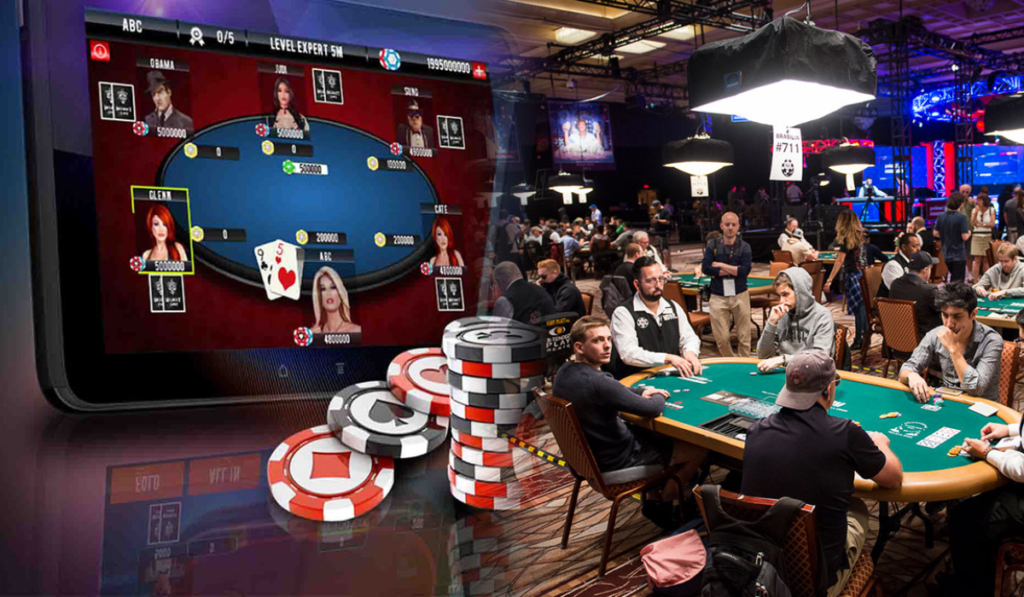
Online Poker vs Live Poker: Unveiling the Key Distinctions
Online poker and live poker may share the same fundamental rules and strategies, but beneath the surface, they are two distinct worlds. Whether you’re a seasoned player or just starting out, understanding the differences between these two formats is crucial for success. In this comprehensive guide, we’ll explore nine key distinctions that will help you navigate the transition between online and live poker seamlessly. So, let’s dive in!
1. Softness of Games: Online vs Live
When it comes to game difficulty, online poker at higher stakes, such as NL200, can be incredibly challenging. Seasoned grinders dominate these games, making it tough to secure consistent wins. On the other hand, live games at comparable stakes tend to be much softer. In most casinos, games below NL200 are not financially viable, resulting in a more recreational player pool. As a result, a skilled online NL10 grinder would likely be a favorite in most live NL200 games. However, it’s important to note that the level of competition can vary depending on the specific casino or poker room.
2. Pace of Play: Online vs Live
One of the most noticeable differences between online and live poker is the pace of play. Online players are accustomed to playing multiple tables simultaneously, seeing hundreds of hands per hour. In contrast, live games limit you to a single table, significantly slowing down the gameplay. Live dealers require time to shuffle and deal cards, collect chips, and distribute pots. Additionally, many live players prefer a more relaxed approach, taking their time and engaging in conversation. Consequently, you can expect to see only 30-40 hands per hour in most live games. Adjusting to this slower pace is essential when transitioning from online to live poker.
3. The Importance of Physical Reads in Live Games
One of the most significant distinctions between online and live poker is the presence of physical reads in live games. While some players may dismiss the significance of poker tells, they can provide valuable insights when used effectively. Physical tells, such as chip slamming or changes in behavior, can inadvertently reveal the strength of a player’s hand. By paying close attention to these cues, you can gain an edge and make more informed decisions. However, it’s important to remember that physical reads should be used in conjunction with other strategic elements and not relied upon solely for success.
4. Multiway Pots: Live Games vs Online Games

In live games, multiway pots are far more common compared to online games. Online players tend to fold marginal hands and move on to the next table, whereas live players often choose to play speculative hands to avoid boredom. Cold-calling 3-bets and multiple players joining the action is a regular occurrence in live games, particularly at lower stakes. As a player transitioning from online to live poker, you’ll need to adapt your strategy to handle these multiway pots. Patience and wait for favorable opportunities to capitalize on and make disciplined laydowns when necessary.
5. Bet Sizing Flexibility: Live Games vs Online Games
Bet sizing in live games offers a level of flexibility that is not as prevalent in online games. In online poker, players tend to adhere closely to optimal bet sizings based on hand strength and board texture. However, in live games, players often prioritize their hand’s strength over the size of the bet. Consequently, you can experiment with different preflop raises to gauge your opponents’ willingness to call. Additionally, postflop, you can vary your bet sizes to control the pot or extract maximum value. Balancing your bet sizes becomes less of a concern in live games, as long as you’re not facing particularly tough opponents.
6. Exploiting Your Table Image: Live Games vs Online Games
In online poker, you’re just one of many players, making it challenging to establish a distinct table image. Live games, on the other hand, afford you the opportunity to build a reputation among your fellow players. Spending several hours at the same table allows others to observe your gameplay and develop perceptions about your style and tendencies. By understanding how others perceive you, you can exploit your table image to your advantage. For example, if players tag you as a big bluffer, you can use this perception to make profitable bluffs or extract extra value from strong hands. Being aware of your table image and using it strategically can significantly impact your success in live games.
7. Win Rate and Monetary Gains: Live Games vs Online Games
While live games are generally softer, winning more money playing live poker is not guaranteed. Although your win-rate in terms of big blinds per 100 hands (BB/100) may increase significantly in live games, you’ll play far fewer hands per hour compared to online poker. For example, if you win at a rate of 2BB/100 online and play 600 hands per hour across multiple tables, you would need to win at least 12BB per hour in live games to achieve the same monetary gains. It’s essential to gauge your success in terms of money won per hour rather than solely relying on big blind counts.
8. Rake Considerations: Live Games vs Online Games
Rake, the fee charged by casinos or poker rooms for hosting games, is an important factor to consider when comparing online and live poker. While online players often complain about rake, live games tend to have higher rake structures, particularly at lower stakes. Some live games even implement an uncapped rake, deducting a fixed percentage from every pot, regardless of its size. Additionally, you’re unlikely to receive substantial rakeback in live games, unlike in online poker where promotions and leaderboards can provide additional benefits. Understanding the rake structure and its impact on your profits is essential when deciding between online and live poker.
9. Flexibility of Schedule: Online Games vs Live Games

One of the significant advantages of online poker is the flexibility it offers in terms of scheduling. Online players can join games at any time, day or night, thanks to the availability of tables with substantial traffic. In contrast, live poker games are typically spread during the afternoon and night, with peak traffic occurring on weekends. If you’re looking to find good live games, you may need to adjust your schedule and play late into the night. Online poker provides the freedom to set your own schedule, making it a better option if flexibility is a priority.
A Matter of Personal Preference
In the end, choosing between online and live poker boils down to personal preference. It’s crucial to acknowledge and accept the differences between these two formats and weigh them against your own preferences. If you enjoy the presence of other players and can adapt to a slower pace, live poker can offer a vibrant and engaging atmosphere. However, if flexibility and control over your schedule are paramount, online poker provides the convenience and freedom to play whenever you desire. With solid foundations and an understanding of the nuances, you can thrive in either format and gradually build your bankroll.
In conclusion, online poker and live poker offer distinct experiences, each with its own set of advantages and challenges. By recognizing and embracing the differences, you can navigate the transition between the two formats with ease. So, whether you’re a fan of the fast-paced online grind or the lively atmosphere of live games, remember to adapt your strategies and tactics accordingly. Best of luck at the tables, and may your poker journey be filled with success and excitement!
